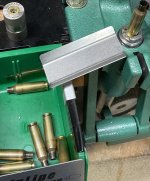You do seem to have a lot of variables in the mix. One thing I'll point out is that brass length growth above chamber size will occur during resizing because the die squeezes the case narrower, and the extra brass extrudes out as extra length. So, going into the die, first, a case gets narrower and longer from head to shoulder, and then after the shoulder makes contact with the die shoulder and you push the case in still further, it starts to shorten again until it gets back down to chamber size and then as you go further, one usually tries to shorten it another thousandth or two. When that is done, the resulting extra brass extrudes up into the neck, so this is when neck length increases and internal donuts form. And that's all in standard dies. The Forster Bushing Bump die is an exception that does not narrow the sides, leaving the case chamber-fat.
Regarding the photos, if you know the chamber is right, then we are back to the diameter of the brass being wider than the gauge, and it will scuff Dykem, Magic Marker, or whatever you might apply to a case to confirm this. If the brass that doesn't fit into the gauge will still chamber, it just isn't being narrowed enough by the resizing die to fit the gauge. Some gauges mimic both SAAMI minimum chamber diameters and headspace length, while others are loose on diameter and only gauge lengths. I don't have any cartridge gauges by Hornady and didn't locate them on their website to read about how they are made, so we'd have to call and ask.
The only other thing I can think of to check is case wall runout. A case significantly too thin on one side can become oval in cross-section due to the thinner part getting springy, and that's an issue you can check for with calipers.

One last thought regarding the primer pocket expansion: some brands of brass will have harder heads than others. You might consider going through a round of brass brand sampling as it becomes available.
Regarding the photos, if you know the chamber is right, then we are back to the diameter of the brass being wider than the gauge, and it will scuff Dykem, Magic Marker, or whatever you might apply to a case to confirm this. If the brass that doesn't fit into the gauge will still chamber, it just isn't being narrowed enough by the resizing die to fit the gauge. Some gauges mimic both SAAMI minimum chamber diameters and headspace length, while others are loose on diameter and only gauge lengths. I don't have any cartridge gauges by Hornady and didn't locate them on their website to read about how they are made, so we'd have to call and ask.
The only other thing I can think of to check is case wall runout. A case significantly too thin on one side can become oval in cross-section due to the thinner part getting springy, and that's an issue you can check for with calipers.
One last thought regarding the primer pocket expansion: some brands of brass will have harder heads than others. You might consider going through a round of brass brand sampling as it becomes available.

